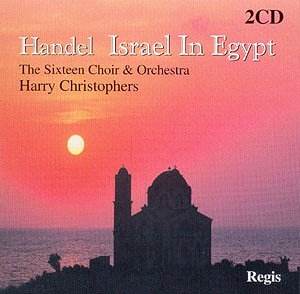Handel wrote Israel in Egypt in October 1738, when
he was 53 years old. This oratorio was intended to appeal to Christians
as a work for Lent, and to the important Jewish community in London
as a work suitable to Passover. Yet this work met little success - it
is a choral oratorio. In its original version, it had only four solo
arias and almost forty choruses - this did not fit with audience expectations
at the time. After a revival in 1756, Handel wrote that this work was
"too solemn for common ears".
It indeed starts off in a very solemn mode, with a
slow, dense introductory movement, marked Largo assai, that sets the
tone for the work. But the lack of solo arias is in no way a defect.
While Handelís contemporaries may have disapproved of the work, I think
modern listeners, who appreciate Handelís choral writing, will enjoy
it very much. While it is rather austere in its melodies - sounding
more like a mass than an oratorio - it shows some of Handelís finest
choral writing. The choir here is more of a character, since it is providing
almost all of the narrative. And the Sixteen Choir is well-suited for
this music - subtle, intense, austere or bright as needed, this excellent
choir gives the music its full range of tones and colours.
Harry Christophers has chosen to insert, as an "interlude",
the Organ Concerto in F, HWV 295, between parts I and II of the work.
While there is not essential reason for this, using this work as "filler"
is quite attractive, and is well-played by Paul Nicholson and the Sixteen
Orchestra. This work features the organ as soloist with a "small"
sound - the organ is not loud and intense, but rather sinuous and enigmatic.
The final movement, marked Adagio (ad libitum) is played by the organ
alone, and sounds like a brief organ improvisation.
With the reserve that those listeners who shy away
from choral works may not enjoy this oratorio, this is certainly a unique
work. The excellent Sixteen choir gives a brilliant performance, and
this is an enjoyable recording.
Kirk McElhearn


